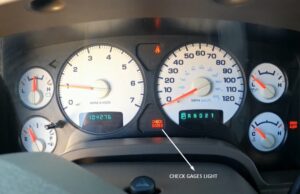Check gages is a critical indicative light seen most often by users on the instrument cluster of a Dodge Ram.
Though there are many other indicative/ warning lights visible in the instrument clusters, we will discuss some of the important ones. Each of them has its unique function.
Here we have five essential indicative lights that should not be IGNORED:
- Check Engine Light (CEL) – This indicates that one of the sensors connected to the engine is not performing right. There may be several possible reasons behind this light.
- Low Oil Pressure Warning – Lights up if oil pressure inside the engine is low.
- Parking Brake Alert – This lights up when you forget to liberate your car’s handbrake.
- Coolant Temperature Warning – This indicates when a car’s engine is overheating.
- Battery Charging System Alert – This indicates that the charging system is not working properly or the battery needs to be replaced.
There are various other indicative lights visible on the dashboard, in addition to the five listed above.
Where is The Check Gauge in Dodge Ram 1500?

Gages in Dodge Ram 1500 have designated positions. Dodge Ram 1500 has the most common gages on the instrument cluster.
Gages in the past were mostly analog in appearance, but today we have all digitally styled gages.
In a car, we have Electrical and Mechanical Gauges. The most common gauge found on a dashboard is the speedometer and odometer.
Moreover, there might be a tachometer, fuel gauge, oil pressure gauge, engine temperature gauge, and voltmeter.
But where can we look for a check gauge light? Typically, each type of vehicle determines its position.
The position of the Check gauge light differs since instrument clusters vary by model. It is often seen to be in yellow or red color.
A check gauge light is located below the speedometer and tachometer on your dodge ram 1500 dashboard.
Sometimes it is also found on the upper right or left side of the dashboard or immediately next to the fuel gauge.
Causes of Check Gages Light Dodge Ram
Small things matter in everything. Each part of equipment or object has its purpose.
Each has its purpose, and we shouldn’t ignore what problem is it trying to indicate. Fixing it should always be our priority.
Now, let’s talk about what a check gauge means in a Dodge Ram. When lit up, it illuminates in orange or red. It comes up in a Dodge Ram usually when there is a fault in the car.
The fault may be related to any of the gages only. Sometimes, check gage illuminates to remind you that multiple indicative lights are turned on.
When a check gauge light is triggered, you need to immediately run a diagnostic scan, as it detects that some of your gauge readings are inappropriate or out of normal range.
Here is a list of reasons or possibilities behind when check gage lights up:
01. Overheated Engine
I can bet that this is one of the most common problems in a vehicle. A Temperature Gauge is used to determine whether the engine temperature is optimal or not.
When the engine runs at a very high temperature, the check gauge light gets activated.
Usually, this happens when the engine cooling mechanism is not working correctly.
02. Blown Fuse
This can be one reason the check gauges light up. A blown fuse will deactivate one or more essential electrical items in your car.
Finding the blown fuse and replacing it with a similar one will fix the issue.
03. Low Oil Pressure
Engine oil plays a vital role in lubricating and removing heat from the parts inside a running engine.
When oil cannot flow through the engine, oil pressure decreases, which affects lubrication.
At this time, the oil pressure gauge shows abnormal pressure readings, and check gages light up. A car that is running low on oil might show the same symptoms.
04. Low Tire Pressure
This signal indicates that your car tires are not properly inflated. Driving with improper tire pressure is not a wise idea, so check gages lights up to remind you to look into the tire pressure monitoring system.
05. Thermostat Issues
When the thermostat gets damaged or broken, it significantly affects engine temperature readings.
Thermostat issues cause problems in the cooling mechanism of the engine. This again triggers the check gauge light.
06. Bad Water Pump
Failure to circulate coolant around the engine will overheat it, increasing the temperature gauge reading. To address this overheating issue, yet again, check gages will be activated.
07. Charging System Issue (Battery Warning)
When your battery is draining or being used, a red battery icon will appear on the console.
You should immediately check your car battery wiring as there could be a chance it was loose.
If this is still turned on, then your car’s battery might run out of juice, and you’ll be stuck somewhere. Charging system malfunctions also activate the check gages light.
08. Vacuum Leak
When your vehicle has a vacuum leak, this will result in a rising temperature in the engine compartment.
Immediately alarm your car’s temperature gauge and light up the check gauge.
This is an expensive fix, but if it is not fixed immediately, the vehicle’s engine may suffer further damage.
How To Fix Check Gages Issue
Of course, you have ways to fix any damage in a car. We have various options to resolve rising issues and bring back a car to life.
The check gauge means a lot in a Dodge Ram. Any driver shouldn’t put it aside when it is turned on. Now, let’s discuss some of the best remedies to resolve the problems mentioned above.
01. Overheated Engine
You need to take action when your vehicle has early signs of overheating. If we continue to operate a car at a very high temperature, this can cause irreparable damage.
Here is a list of possible solutions you can do to solve this problem:
01. You must stop driving immediately, turn off your car’s air conditioning unit, and shut down the engine.
Please turn on the heater as it will bring the heat from the engine to the cabin. In this way, you can cool off the engine.
02. Open your hood to release some steam, and add sufficient coolant to the radiator, as it depletes faster when your car is overheating.
Be careful when opening a hot radiator cap, or your hand might get burnt.
03. One best option is to drive your vehicle to a service station if you have time.
It can be checked thoroughly there. Don’t hesitate to replace damaged or malfunctioning parts.
02. Blown Fuse
A blown fuse is a problem that can be fixed quickly, therefore you don’t need to panic when this happens to you.
- The standard solution for this is removing a damaged fuse and replacing it with a new one
- You must first open your car’s fuse box and find out which fuse is damaged. You can use pliers or your bare hand to pull out a blown fuse
- Change a blown fuse with a new one of exactly similar rating, put on the fuse box cover, and try to restart your car
- Do it yourself with the guidance of a manual; if this doesn’t work, then you must take your vehicle to a service station
03. Low Oil Pressure
Proper oil pressure is needed to protect a car’s engine from deterioration. Here are some steps to check and solve if your vehicle has low oil pressure:
a) Check your car’s dashboard to see if the oil pressure warning light is on; if it is, your vehicle has low oil pressure.
b) Start your car and let it idle. Now, observe if a loud or seizing noise is coming from it.
Get help from a technician immediately if you hear clunking, ticking, or grinding noise.
c) To inspect the low level, you can use the dipstick. Pull it out, clean it with a rag or paper towel, put it back, and bring it out again.
Check if the oil level is between the maximum and minimum mark. The dipstick also helps you determine whether your oil is already dirty.
d) Check if your oil filter is working perfectly. Check for any drop of oil leaking around the filter.
Replace the oil filter on every oil change. You don’t want to damage your engine due to a clogged oil filter.
e) Check your car’s oil pump pulley and belt for misalignment. Try to wiggle the pulley by hand to check for sideways movement.
If the pump shows any damage, call a mechanic and have the oil pump replaced.
04. Low Tire Pressure
Before heading out, you must inspect if your tire is inflated to the recommended air pressure. Here are some tips to get over a low tire pressure problem:
# pull to the nearest gas station and inflate your tires if you are already out.
# Do a routine maintenance check on your tires to see their condition. Check the valves on every tire if it losing air very slowly.
# If you can’t solve a problem yourself, call a mechanic.
05. Thermostat Issues
Thermostat issues are a bit complex to inspect and solve.
- Keep your car on a level surface and ensure the engine and radiator are at ambient temperature.
- Now crank up the engine and wait until it idles. If any coolant is flowing, see into the radiator by removing the cap. It might take some time for the engine to get to its operating temperature.
- If coolant flows, the thermostat is working properly. Otherwise, it is damaged and must be replaced.
06. Bad Water Pump
When your water pump is not functional, you don’t have another option but to replace it.
You can follow the same steps instructed for a thermostat issue. A failed water pump will prevent coolant from flowing into the radiator.
07. Charging System Issue
01. It would be helpful if you inspected your battery wiring, alternator, and belts.
02. Check if your car’s battery is charging correctly using a battery tester or a simple multimeter.
Crack the engine and place the probes on the battery terminals; it should read above 14 volts.
If the terminal voltage is below 14, even after stepping into the gas pedal, there is some problem with the charging system.
03. Inspect your battery wiring and terminals for rust and wear. Check the alternator pulley for misalignments or slippage.
If you are hesitant to do all this stuff, you can always seek help from an expert.
08. Vacuum Leak
Vacuum leak causes several engine problems. Rough idling is a common one.
Any leak in the air intake or loose connection of the hoses can result in a vacuum leak. Locating the leak is a tiresome job.
- Start up your car and get under the hood
- Spray some water using a spray bottle onto the air intake hose
- If you can see that water gets sucked into the hose, then you have found your leak
- You need to replace the portion of the hose and see if it works. If it still causes trouble, always get your car to a service station
How Far Can You Drive With a Check Gauge Light Up?
In some situations, we don’t have a choice but to drive even after a check gage flashes up. This is a usual scenario.
There is no exact time limit on how long you can continue driving your car in such a condition.
However, when a check gauge does light up, you shouldn’t ignore the warning. You need to know what issue or problem triggers it to light up.
You can keep driving for any minor issue, but it’s best to limit your distance if you can visit a service station. But what are you going to do if this happens to your car?
Step 1
Pull over immediately and turn off your car’s engine.
Step 2
Check all the indicative lights on the instrument cluster and try to isolate the problem.
Step 3
If you see any lit-up signs on your car’s dashboard, know the problem or if any gauges have given a false or no reading.
Step 4
After you know your vehicle’s problem, give it a try and fix it. If you can’t sort out the problem, call for a tow service or drive to the nearest service station.
What If The Check Gauge Light Keeps Coming?
A check gauge light rarely illuminates continuously, primarily after addressing specific problems you have noticed.
After all of your efforts, if you still see the check gauge light turned on, your best option is to seek help from a mechanic.
The time required to fix car problems depends on your vehicle type and the severity of the damage.
Usually, it takes 30 minutes to fix an overheated car, but in extreme conditions, it will take a day or more and cost between $100 and $1500.
If you want to fix the low oil pressure issue, it may cost between $121 and $160.
To sum up, if your vehicle has multiple damages, it may cost you as much as $5000 – $10,000.
Frequently Asked Questions
Is it Safe To Drive With The Check Gauge Light on?
Driving with a check gauge lit up might be safe, or it might not, depending on what issue triggers the car’s check gauge to light up. But first, you can pull over and check your vehicle.
After you have inspected and discovered what caused the check gauge to light up, you can still decide to drive.
If your issue is an overheated engine, it is much safer to call for professional support.
If problems like low tire pressure or low oil pressure occur, you can still drive to the nearest gasoline station to solve them. Always decide to ensure safety before moving on.
Can I Reset The Check Gauge Light in My Vehicle?
Of course, you can reset your vehicle’s check gauge light. The best way to reset this is to find the problem and fix it.
There is no button to reset the check gauge light automatically, but you can turn off the engine, wait for a while, and start-up.
If the fault were cleared, the check gauge light would turn off automatically.
What Do I Do If There is No Other Indicator Light That Illuminates Aside From The Check Gauge Light?
Usually, the check gauge light is triggered by other indicator lights or gauges.
If a check gauge light is on but no other indicator is lit up, call a mechanic or certified technician to fix the problem.
A mechanic can run a full scan of your vehicle and check for wiring issues, wear and tear, or damage to the car.
If no light other than a check gauge light illuminates, then the problem is something profound and internal.
Final Thoughts
Staying calm in a problematic situation is one of the best options.
Now that you have reached the end of this article, we hope you have already gathered enough knowledge about the check gauge light and what to do in such a condition.
Check your car thoroughly before going out for a long drive, and you’ll be good. Your car is as valuable as yours.
Protect your vehicle at all costs and solve problems as soon as they arise. Be well-informed and aware to protect yourself from accidents.

Bruce William is a professional content writer and vehicle engineer with extensive car maintenance and repair knowledge. His expertise spans all vehicle parts, offering practical solutions for various automotive issues. Bruce provides valuable insights through his website articles to help readers maintain their cars for optimal performance and longevity.

